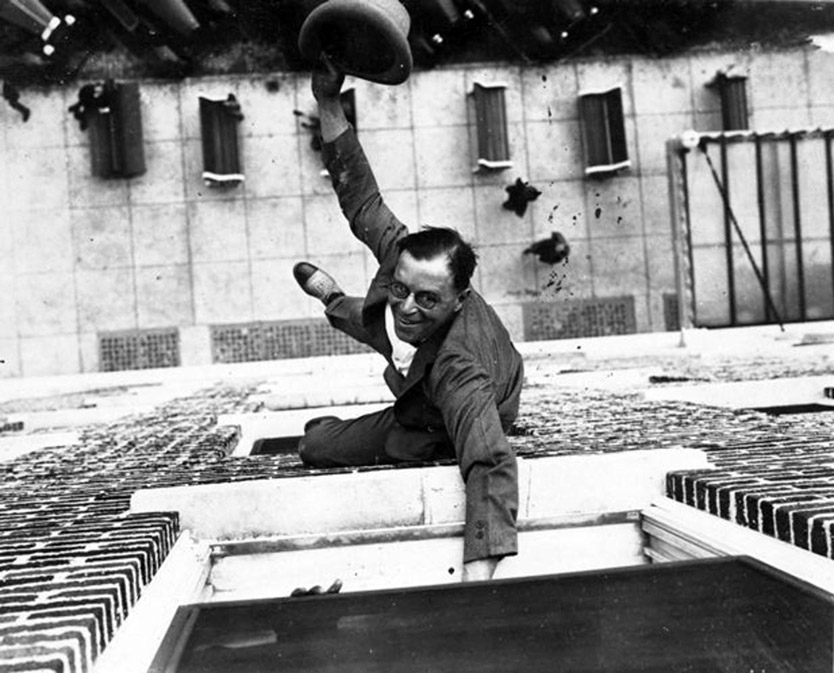the “human fly”
Scales the First National Bank
On July 30, 1927, a bespectacled middle-aged man walked up to the First National Bank building on the square in Gettysburg. He looked up at the edge of the roof, more than three stories above him. Then, instead of walking inside, he grabbed hold of one of the stone columns next to the door and began climbing.
Harry Gardiner was obviously no typical middle-aged man. He was the best known of the daredevils in the early 20th century, known as the “Human Fly.” Gardiner made his living climbing buildings and other structures and performing gymnastic tricks. Gardiner had started his unusual career in 1905, and over the next quarter century, he climbed more than 700 buildings.
“These guys didn’t use ropes or nets or suction cups,” said author Michael Largo on a video clip on Dailymotion.com. “They wore normal ordinary clothes, especially Harry Gardiner. He would have his bifocal glasses and regular clothes.”
Gardiner, who was 58 years old at the time, easily scaled the building like Spider-Man in the comic books. At the top of the building, he stood on his head on the cornice and did other stunts. During an earlier climb of the building, the Gettysburg Times described some of his tricks on the roof:
“He leaned backward and stood upward in the same movement, gripped the edge of the cornice and let his body hang down straight.
“The crowd gasped.
“Now the limp body began to swing, back and forth, like a pendulum, rising higher, higher at each sweep. Suddenly its motion seemed strangely accelerated, a second time it swung, and then—the feet shot straight out, the heels reached up to and rested on the cornice and held tight.
“A moment’s wait and then the body seemed shaken with short quick convulsions—as if it were shot through and through with a powerful electric current. But at each convulsion the heels moved farther from the point where the finger-tips gripped hard until, in another moment, the body was almost straight. The head and shoulders rose, pulled up by the powerful arms, the trunk of the body rolled upward and over, the left hand shot still higher up and gripped a crevice in the wall.”
Following his tricks, Gardiner climbed down the building as easily as he had climbed up.
Because Gardiner did not use safety equipment of any kind, his climbs were truly death-defying. Gardiner had had two bad falls on previous occasions. In Columbia, South Carolina, he had fallen 50 feet and broken ribs and lacerated his scalp. During another climb, he had fallen 45 feet and injured his head, according to the Gettysburg Times.
The American Legion had invited Gardiner to Gettysburg to climb the First National Bank and another building. He was guaranteed $50 and half of a collection that was taken up among the crowd that had gathered to watch him climb. The other half of the collection went to the American Legion.
This was not Gardiner’s first visit to Gettysburg. He had performed similar climbs when he visited in 1920. During that visit, approximately 6,000 people gathered on the square to watch Gardiner.
On October 7, 1916, Gardiner climbed the 12-story Majestic Building in Detroit, Michigan, wearing all white and tennis shoes.
On January 30, 1917, he climbed the 16-story Empire Building in Birmingham, Alabama.
The following year, he climbed the 17-story World Building in Vancouver, British Columbia to promote Victory Loans.
On November 11, 1918 he climbed the Bank of Hamilton building in Hamilton, Ontario, to celebrate the end of World War I. He took a break during the climb to stick his head in a window and sign some insurance papers.
It is not known when Gardiner died. Largo notes that when U.S. cities started passing laws against climbing the outside of public buildings, Gardiner moved to Europe.
“A person of his description was found beaten to death at the bottom of the Eiffel Tower many years later,” Largo said.

Photo shows Harry Gardiner, known as the “Human Fly,” climbing the 17-story Sun Tower Building in Vancouver, Canada, in 1918.

